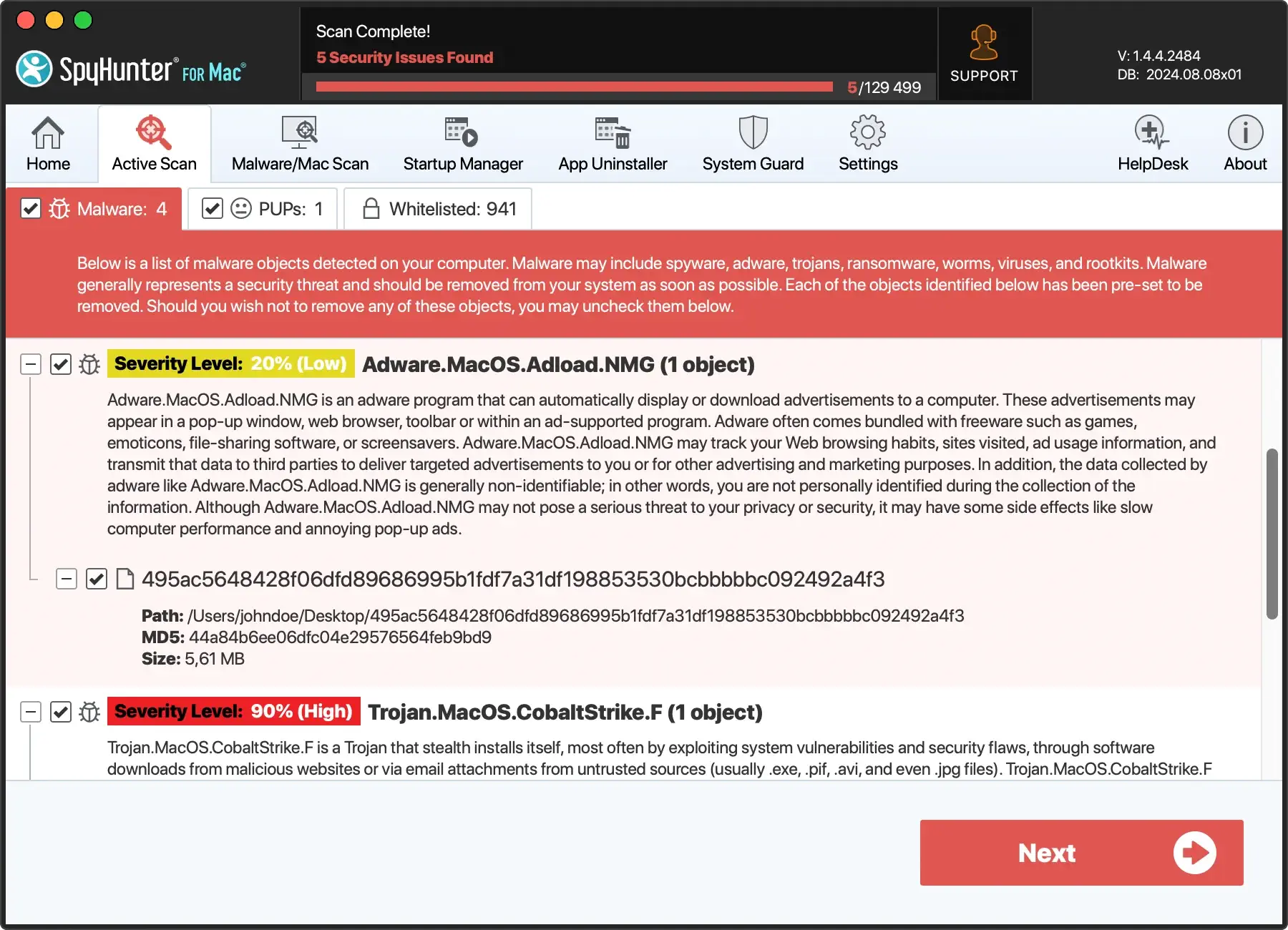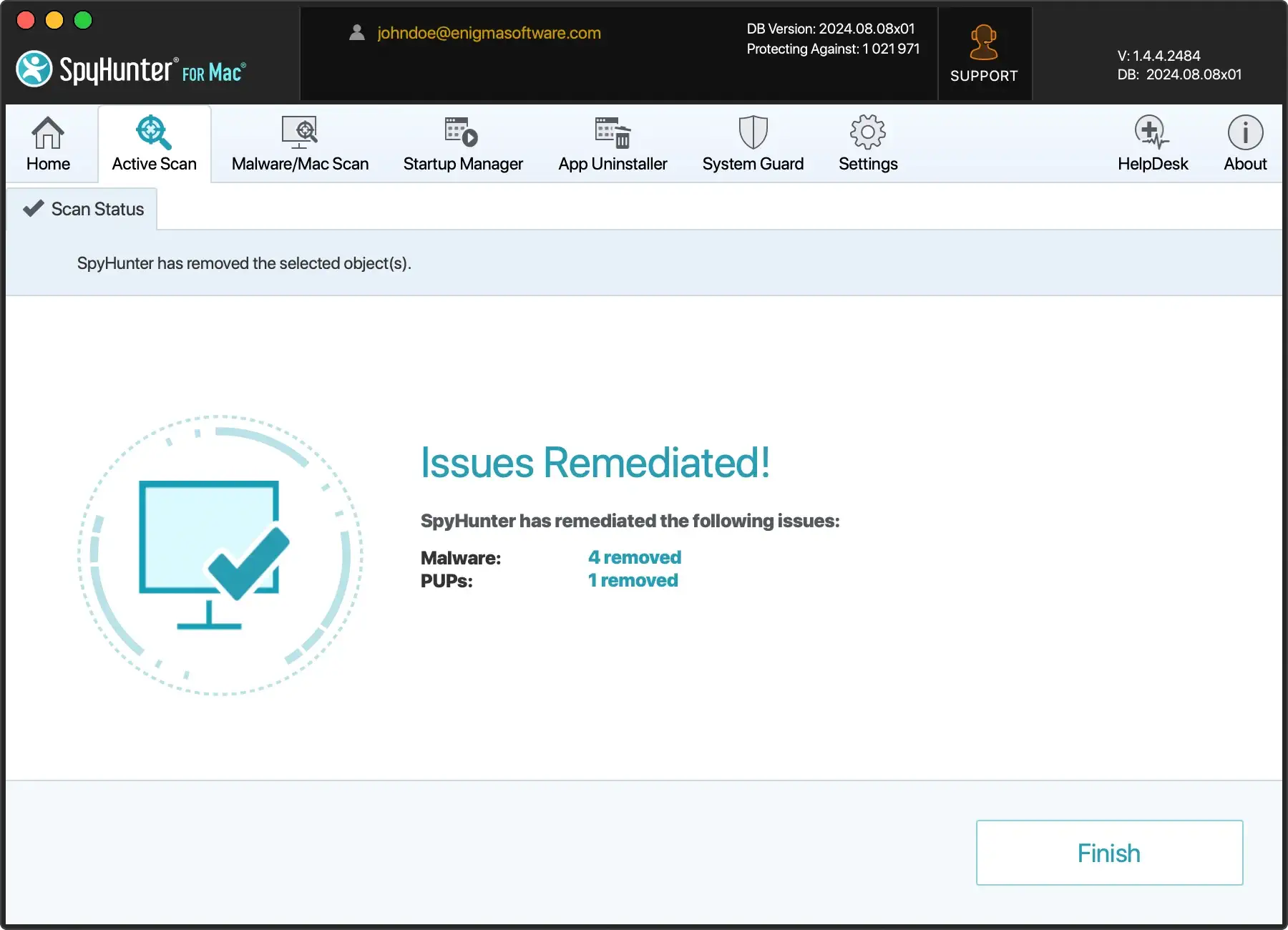Remove “Mac Os: The System Is In Danger” Alerts [Easy Guide]
Before we dive in
Before we dive in, let's make sure you stay safe online. We created SpyHunter because your security matters to us.
Protect your computer today — download SpyHunter right here! Check out our top tips below to keep your computer safe and secure.

Ever stumbled upon a sudden, alarming alert on your Mac that claims your system is in danger?
These Mac OS fake alerts might look convincing at first glance, but they’re usually nothing more than scams trying to trick you into downloading harmful software or fork over cash for nonexistent problems.
This article examines Mac OS fake alerts, explores their common triggers, how to identify them, and steps you can follow to remove them from your system.
What exactly is the Mac OS fake alert phenomenon?
Fake Apple security alerts on Mac OS, including the “Mac OS: The system is in danger” messages, are fraudulent schemes designed to appear as legitimate warnings.
These alerts are typically displayed during web browsing and falsely inform the user that their system is at risk, encountering severe errors, or infected by viruses.
The ultimate goal behind these alerts is to scare the user into taking immediate action, usually by contacting a fake tech support service or downloading rogue software.

This type of scam leverages the appearance of genuine Apple security notifications to deceive users.
Once the user is convinced of the purported threat, scammers may prompt them to grant remote access to their device, make a payment for repair services that are not needed, or install software that could compromise their system’s security.
Common triggers for Mac OS fake alerts
Understanding what causes these fake alerts to appear can help you prevent them.
One common trigger is visiting compromised or low-security websites that host malicious advertisements. These ads can redirect you to pages displaying the fake alerts.
Another prevalent cause is already existing adware or malware on the system. A potentially unwanted application installed without the user’s knowledge can modify browser settings, alter the appearance of legitimate sites, or generate intrusive pop-ups.
Additionally, clicking on suspicious links in emails or social media can also redirect users to these fraudulent warnings.
To safeguard against these triggers:
- Avoid clicking on unexpected links or ads, especially from unknown sources.
- Regularly update your web browser and security settings to guard against vulnerabilities.
- Install reliable cybersecurity software to detect and remove potential threats.
How can you quickly identify a phishing scam on Mac OS?
Identifying a phishing scam on Mac OS can be done swiftly if you know what to look for.
First, be wary of unsolicited communications. Whether it’s an email, a popup notification, or a browser redirect, unexpected requests to verify your account or confirm your details are red flags.
If an alert or message urges immediate action, such as threatening to close an account or cancel service, it’s likely a scam attempting to create a sense of urgency to provoke a hasty response.
Visual clues that scream ‘scam’
Several visual cues can help you recognize a scam. Look out for poor graphic quality in logos and images that should otherwise be crisp and professional on legitimate notifications.
Also, check for mismatched fonts, erratic font sizes, and spelling mistakes. These inconsistencies often indicate that the message is not from a legitimate source.
Official updates or alerts from Apple will not have these errors. Additionally, a pop-up or an email that fails to address you by your full name, instead using vague greetings like “Dear user,” or “Hello, Mac user,” can also be a sign of phishing attempts.
What do fake Mac OS alerts usually claim?
Fake Mac OS alerts typically claim that your system is severely compromised, alleging the presence of viruses or severe technical failures.
They might state that your computer will be locked, or your data will be lost if immediate action isn’t taken.
Such alerts often include urgent calls to contact a support number. This sets the stage for scammers to potentially introduce malware such as remote access tools or to push unnecessary software purchases and services.
In such cases, relying on trusted security software is advisable to safely identify and remove potential threats.
Step-by-step guide to removing Mac OS fake alerts
If you’re seeing fake security alerts on your Mac OS, it’s likely due to adware or malware.
Resolving this can greatly enhance your system’s security and performance. Below, we’ll guide you through the necessary steps to clean your Mac and restore its functionality.
Step 1: Removal of suspicious applications
Malicious applications are often at the root of fake alerts. You’ll need to identify and remove these applications to stop the alerts.
- Open
Finderand click onApplicationsin the left pane. - Browse this list, looking out for any programs that you don’t recall installing and for suspicious apps.
- Right-click the dubious application and select
Move to Trash. - Finally, to permanently remove these apps, right-click the trash icon on your dock and select
Empty Trash.
Step 2: Clean your browsers
Your browser can also be a gateway for security threats. It is crucial to reset your browser settings and remove suspicious extensions to protect against further issues.
For Safari
- Open the
Preferencesmenu by clicking on the Safari menu in the top menu bar, then choosePreferences. - Go to the
Extensionstab and review the list for any unrecognizable or unnecessary extensions. - Uninstall these by selecting the extension and clicking
Uninstall. - Reset Safari settings by navigating to the
Advancedtab in the samePreferenceswindow and clickingReset.
For Google Chrome
- Open Google Chrome and click on the three dots in the upper-right corner to access
Settings. - Go to
Extensionson the left menu and look through the list for extensions you did not install voluntarily. - Remove these extensions by clicking
Remove. - For a full reset, return to settings, scroll down, and click on
AdvancedthenReset and clean up.
For Firefox
- Access Firefox options by clicking on the three horizontal bars in the top-right corner, then select
Add-ons. - Review installed add-ons and remove any that you did not install or that seem suspicious by clicking
Removebeside the add-on. - To reset your Firefox settings, go back to the main menu, choose
Help, thenTroubleshooting Information, and click onRefresh Firefox.
Remove the source of scam pop-ups with SpyHunter
SpyHunter is tailored to detect and remove spyware, ransomware, and other malware specifically engineered to affect macOS systems.
Its user-focused design ensures that even users with minimal technical knowledge can navigate threats effectively.
SpyHunter’s adaptive malware remediation functionality goes beyond simple detection. It actively adapts to the evolving cybersecurity threats and is regularly updated to keep up with new malware targeting macOS.
- Download the app here and finish the installation process as described on your screen.
- Launch SpyHunter from your Dock and select to run a full scan from the main menu.

- Wait for the scan to finish and scan the list of detected malicious files and applications.
- Proceed with the automated removal process to enjoy a safer and cleaner system.

Proactive measures to prevent future fake alerts
Protecting your devices against fake security alerts involves adopting a proactive approach.
Ensuring your operating systems and applications are up-to-date is the first step. Software developers often release updates to patch security vulnerabilities that could be exploited by cybercriminals to deliver fake alerts.
Engage in safe browsing habits, avoiding suspicious websites and not clicking on unverified links.
Additionally, consider using comprehensive security software, such as SpyHunter, which can help detect and remove malicious threats before they compromise your system.
Tips for enhancing your browser’s security settings
Securing your web browser is crucial in preventing fake alerts and other security threats.
Start by adjusting the security and privacy settings to block unauthorized pop-ups and control site permissions.
Install ad blockers and anti-tracking tools to reduce the risk of encountering deceptive ads and prevent malicious sites from tracking your online activities.
For stronger protection against malware, consider integrating an antivirus app, which offers real-time threat detection and removal capabilities and can handle any malicious app or potentially unwanted app.
FAQ on Mac OS security
How can you distinguish legitimate Mac OS notifications from fake notifications and scams?
Identifying genuine Apple security alert messages and Mac OS notifications from fraudulent ones can be tricky, but there are signs to look out for.
Real notifications will typically not generate alarm or demand immediate action regarding system security threats. Alternatively, scam alerts often include typos, unusual wording, and appeal to urgency.
Authentic Mac OS notifications will prompt you through standardized menus and options, not through web pages or unexpected pop-up windows.
Always cross-check these alerts through the system’s app settings before responding.